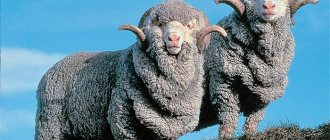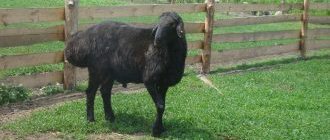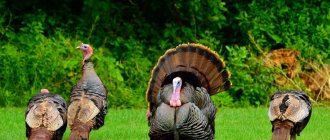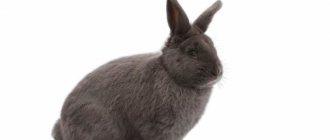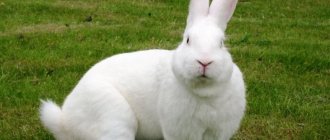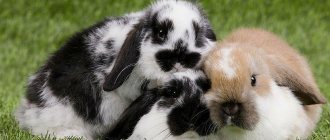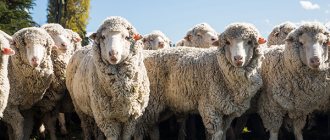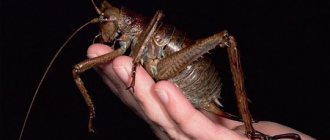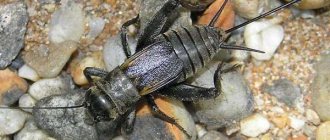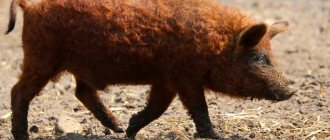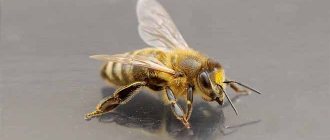Each type of rabbit differs in size, fur color, body weight and living conditions. Dwarf breeds are considered the most popular. Their small size and attractive appearance have made these rabbits the best pets for home keeping. The fox rabbit is especially popular. It received this name because of the bright shade of its fur. Individuals of this breed are distinguished by their low body weight, dense hair and docile nature.
Distinctive characteristics
Rabbits of this species were first bred in early 1998. It was then that standard parameters for describing animals were adopted:
- The auricles do not exceed 6 cm in length;
- Adults, when properly maintained, will not weigh more than 1.5 kg;
- Rabbits do not have a dewlap;
- The head diameter of males is 6 cm, and that of females is 5.5 cm.
Purebred rabbits can come in a variety of shades. Most often the fur color will be:
- Ginger;
- Black;
- Grey-blue;
- White;
- Chinchilla.
White or chinchilla is considered a popular shade. Mixing colors during the process of crossing individuals is prohibited. If incest occurs during the course, pathological changes may occur.
Rules for choosing a good individual
In order to choose a good and ideally healthy individual rabbit, you need to pay attention to both its external characteristics and characteristic behavioral features.
It is important to remember the following signs that indicate full compliance of an individual with the norms of its breed:
- dense and muscular build;
- weight from 0.8 to 1.5 kg (ideally 1.3 kg);
- thick, dense wool from 40 to 70 millimeters long;
- broad shoulders and chest;
- shortened front legs;
- rounded shape of the rear part with a tight-fitting, vertically directed tail of a small size;
- a large head, which when viewed in profile looks round, and when viewed from the front - short and wide (for females the ideal value at eye level is 50 mm, and for males - 55 mm);
- ears with rounding at the very tips (their length can be from 55 to 70 millimeters;
- expressive and brilliant eyes of large size and slightly convex shape.
In addition, you should be aware of the signs that are unacceptable for a dwarf fox rabbit:
- the body is elongated, elongated, having a loose structure;
- a noticeably narrowed chest in combination with a large and massive dewlap;
- elongated shoulders, the proportions of which are not in harmony with other parts of the body;
- front and rear legs that are too long or crooked;
- a narrowed or sagging lower part of the body with a sagging or insufficiently tight-fitting tail;
- twisted claws;
- elongated or narrowed head shape;
- pronounced elongated neck;
- widely spaced ears, having an elongated shape without curves;
- small eyes lacking a healthy shine;
- short or uneven coat length;
- sloppy fur - matted or dirty;
- excess body weight;
- abnormal exhaustion;
- malocclusion.
When examining a dwarf fox rabbit, you need to pay attention to its fur - in a healthy individual it is shiny, dense and thick, without the slightest bald spots or combed damage. To assess the condition of the skin, you should stroke the animal several times against the growth of the fur. The eyes should be absolutely clean and shiny. The presence of redness and discharge may indicate conjunctivitis.
The next important point is the condition of the ears. There should be no discharge, redness, inflammation or scabs in the inner ear. Discharge from the nasal passages is also unacceptable. When completing the examination, you should pay attention to the condition of the fur surrounding the anus - the presence of stuck together lumps, contamination with feces, as well as an unpleasant odor indicate a pathology of the gastrointestinal tract or the feeding and keeping of the animal in unfavorable conditions.
Fox rabbits have a playful and friendly disposition, so you should be wary if you detect opposite manifestations of character. Under no circumstances should you buy a baby rabbit if it has no interest in the world around you and no appetite, and also if it does not move around the cage, but constantly tries to hide in the house, frightened of people and any sounds. You should also avoid buying an animal whose behavior is characterized by increased excitability and aggressiveness.
Description of the breed
The coat of the dwarf fox rabbit hangs down a little. Externally, the wool resembles a downy coat, the length of which can reach 8 cm. Animals at first glance may seem too fluffy. Rabbits of this species have well-developed muscles and a strong body.
The small body and enlarged head immediately catch the eye. Miniature ears are always raised up. The eyeballs may have a reddish tint. When exposed to light, they appear blue or even white. The forelimbs are shortened.
What is the character of rabbits?
The dwarf fox rabbit has a very peaceful character. That is why the breed has become popular among professional breeders and novice hobbyists. Individuals of this species are often purchased for small children.
Before purchasing, you should take into account the fact that on the surface of the ears of these rabbits there is a huge number of nerve endings. Any sudden movement or physical impact can provoke a defensive reaction in the pet, as a result of which it scratches and bites.
Young rabbits may grunt and squeal when stressed. This behavior is repulsive and even frightening. Regular stressful situations provoke deep depression. This phenomenon is accompanied by intestinal disorders and severe diarrhea. This disease is considered dangerous for a pet. During defecation, a rabbit loses up to 30% of its own weight. Failure to provide veterinary care in a timely manner can lead to death.
After purchasing, it is recommended to place the rabbit cage in a visible place. Animals of this species require regular attention from humans. In the first week, you need to prevent stressful situations. It is forbidden to listen to loud music or make sudden movements near your pet.
The fox rabbit gets along well with other types of pets. Rodents prefer to play with cats and miniature dogs. It is prohibited to purchase individuals into homes where large breeds of dogs live.
Popular fox rabbit breeds
Many years of experience by breeders have allowed us to develop several unusual varieties of fox rabbits. Each type of animal differs in its character, coat color and characteristic features.
The list of breeds includes:
- Dwarf fox. The breed was first bred in 1991 in Australia. These are miniature-sized animals. They have a decorative appearance and thick fur. The length of the coat can reach up to 8 cm. Outwardly, such a rabbit seems voluminous. The fur of the individual is thick and dense;
- Swiss fox. This breed was bred in the early 20s of the twentieth century in Switzerland. A distinctive feature of the breed is the long and silky fur of the entire body. Despite numerous efforts, breeders were unable to obtain fox-like fur. However, its decorative qualities are considered a real reward. The weight of an adult animal can reach 5 kg;
- Foxy silver rabbit. Breeders developed and introduced this breed in early 1920. The breed has long fur with silver streaks. Wool fibers grow perpendicular to the skin. After physical impact, the fur remains unchanged. The body weight of an adult rabbit can reach 6 kg. Skins are widely used for sewing fur products.
Most popular colors
Common fox rabbit colors are white and havana (a rich, warm brown, closer to red-brown than brown-black). In recent years, dwarfs with chinchilla, black and silver fur colors have appeared, although they are not particularly widespread yet.
The main feature of breeding pure lines of these animals is that individuals of different sexes must have the same color, which will be passed on to the offspring and fixed in its genotype.
Long hair is not only an advantage, but also a disadvantage of fox rabbits. In addition to protecting baby rabbits from damage, fur fibers hide physical defects, forcing the owner to regularly inspect and feel the pet’s body.
Remember that a dwarf fox should have a playful and friendly disposition, be inquisitive and constantly explore the surrounding area. If an animal is inactive, constantly afraid of people and extraneous sounds, trying to hide in a dark corner, then this may be a sign of illness or hereditary defects. Be sure to show such a rabbit to the veterinarian.
Conditions of detention
The fox rabbit requires the right conditions. Thanks to this, the animal is actively developing, and the condition of its decorative fur does not change.
Beginning rabbit breeders are advised to adhere to the following rules:
- The temperature in the room should not exceed 20-21 degrees;
- The humidity level should not be higher than 70%;
- For each individual it is necessary to purchase a special spacious cage, inside of which there should be a compact house. This design will act as protection for the pet from prying eyes;
- The flooring in the cage should not be lattice. Miniature front and hind legs can be injured from regular contact with a metal surface. The floor in rabbit cages should be made of natural wood without chemical treatments;
- Regular balanced meals. The pets' diet should include cereal mixtures, fresh vegetables and fruits, a large amount of greens and fresh drink;
- Walking areas. To prevent the animal's muscles from atrophying from lack of free space, veterinarians recommend walking the rodent. An apartment, a garden area or even a balcony is suitable for this.
If all recommendations are followed, it is possible to grow a healthy individual whose life expectancy will exceed 7 years. It is recommended to pay special attention to sanitary treatment of all surfaces.
Important! Rabbits of this breed are susceptible to intestinal diseases.
Appearance
This rabbit looks strong and squat, the body is rather round in shape, densely built. The head of the fox rabbit is large, but the neck is very small; when the rabbit sits, it seems that it has no neck at all. The weight of an adult rabbit is about three kilograms, rarely more.
One of the subspecies of the fox rabbit is dwarf - such rabbits have the same proportions as their larger counterparts, as well as the same coloring, but their size and body weight are much smaller - the weight of such an animal is a kilogram, perhaps a little more .
The ears of fox rabbits stand upright, only when sitting they are pressed to the back (loosely). Another name for this rabbit is dwarf fox.
On a note!
The fox rabbit, a photo of which is easy to see on the Internet, has very fluffy fur, thick, long (up to four centimeters), with a small down. The wool is soft, but at the same time it consists mainly of long, hard hairs (which make up the spine), so this wool mats much less than, for example, the wool of downy rabbits, and does not require such careful care (although you will have to care for the animals and their fur regularly) . In addition, such rabbits are very easy to wash, since the fur is washed well and does not tangle. Wool covers the entire animal, including the ears and face. The hair on the head and ears is smooth, shorter than on the rest of the body.
The colors of rabbits of this breed can be different: brown, red, agouti, there are other color options. An important feature of the breed is the ears; they should not be too long, should be rounded, and not pressed too close to the back. Unrounded, too long ears, uneven colors and spots are considered signs of defects. The color should be even and uniform, without too dark spots. The animals' front legs are relatively short. A rabbit can also be miniature, which is also not considered a defect.
Fox rabbits are very calm, friendly, and treat people well, including children.
The fox rabbit is a semi-long-haired rabbit. Initially, the breed was bred for its fluffy and thick coat, but then it turned out that such wool was not in demand. After some time, fox rabbits began to be bred for their cute appearance - as pets.
The fox rabbit has practically no value - it is not bred for either meat or wool, but it has a calm, cheerful disposition, easily lives both in the house (including in the yard, in the enclosure), and in apartment. The only disadvantage of fox rabbits is their long hair, which requires regular (though not too complicated) care. The wool needs to be combed regularly, make sure that tangles do not form and that the rabbit does not try to comb them out himself, as this is dangerous for the health of these animals.
How to choose a cage
When buying a dwarf rabbit, you need to consider several rules for arranging its home:
- The minimum dimensions of the structure are considered to be 80 cm in height and 160 cm in width;
- The cage material must be made of stainless steel. The thickness of metal rods should not exceed 2 mm;
- The doorway should be twice the size of the rabbit. Thus, he will be able to move freely outside of it.
Where to place your pet's cage
Experienced rabbit breeders recommend installing the structure in a secluded place. Animals should not be near open windows or in direct sunlight.
The animals cannot tolerate high temperatures. Their homes should not be placed near a radiator or open heat sources. Thick fur and well-developed muscles provide them with proper heat exchange.
The area where the cage with the animal will be located must be well lit. You can place the structure with the pet in the corner part. Here he will feel protected and calm.
How to arrange the inside of a cage
A rabbit cage should be as spacious and comfortable as possible. There should be a small house inside for privacy from prying eyes. The feeding utensils should be large so that the animal does not experience discomfort while eating food. The sippy cup should be voluminous. At one time, a rabbit can drink up to 300 ml of liquid.
The defecation tray must be located on the opposite side of the house. Non-coniferous sawdust is used as filler. The presence of tar compounds provokes allergies. It is recommended to clean the tray once a week. It is recommended to clean the container for excrement using antiseptic preparations to prevent the spread of pathogenic microflora. Thanks to this, it is possible to get rid of the pungent odor.
Feeding dwarf rabbits
We told you how to care for a dwarf rabbit. Now let's talk about feeding. What can dwarf rabbits eat? These are herbivorous animals, so the basis of their diet is hay or fresh grass. They should always be in a cage or enclosure. Dwarf breeds have a small stomach, they eat often (almost all the time), in small portions. You can buy hay at a pet store or prepare it yourself. When collecting herbs, it is important to ensure that you do not come across poisonous ones (buttercups, henbane, spurge, lilies of the valley, dope, etc.).
In addition to grass, the diet includes succulent food - carrots, boiled potatoes, cucumber peelings, cabbage leaves, watermelon rinds. Red beets are contraindicated for rabbits. Potatoes can be boiled in salted water. Rabbits can be given fruits - apples, strawberries, pears. Dried fruits are prepared for the winter, which the animals eat with pleasure. It is important to know how much fruit you can give your rabbit. It is best to treat him with such food 2-3 times a week, in the amount of 10-15 grams.
The animals also need to be given grain. You can feed special food for dwarf rabbits, consisting of various grains, dried fruits with hay additives. If this is not possible, make a mixture of oats, wheat, corn and barley in equal parts. So that pets can sharpen their teeth at home, they are given twigs; animals eat rowan, birch, maple, willow, and oak. To prevent vitamin deficiency in winter, spruce or pine branches are useful.
Be sure to include mineral supplements in your diet. Calcium is very important for rabbits. When it is deficient, dangerous symptoms such as convulsions, heart failure appear, and small rabbits can even die from this. To compensate for the deficiency, animals are given bone meal, chalk or special preparations. In winter, it is best to add vitamin and mineral complexes to your diet. If there is a lack of vitamins, rabbits may develop diseases, the treatment of which should be carried out after consultation with a veterinarian.
How to care for a pet
It is necessary to care for a decorative dwarf rabbit in accordance with the requirements of a specialist. To keep the wool dense and soft to the touch, it is necessary to perform the following procedures:
- Brush your rabbit's fur regularly. To do this, you will need a soft brush with rubber bristles;
- Carry out bathing as the fur gets dirty. In hot weather, it is recommended to carry out water procedures once a week;
- Clean your ears. It is necessary to remove visible dirt from the auricle using a cotton swab;
- Near the nostrils, remove visible mucus contamination and traces of filler;
- Regular walks of the animal in an open area will help strengthen its muscle corset and prevent muscle atrophy.
Choosing and purchasing a rabbit
An old proverb says: “If you want a friend, get a rabbit.” It is best to buy a baby rabbit when it is at least 1.5 months old. It is important that all required vaccinations and deworming (preventive measures aimed at treating worms) are completed in advance. Before choosing a pet, you need to look at its behavior and condition. The animal must be curious, active, not afraid and not run away from humans.
Video: Dwarf rabbit
A healthy rabbit can be identified by the following characteristics: - fur evenly distributed over the body, clean, shiny; - eyes are bright, with sparkle; - there is no discharge from the nose; — ears without scratches, sticking up; - the abdomen is soft when pressed; - clean genitals.
